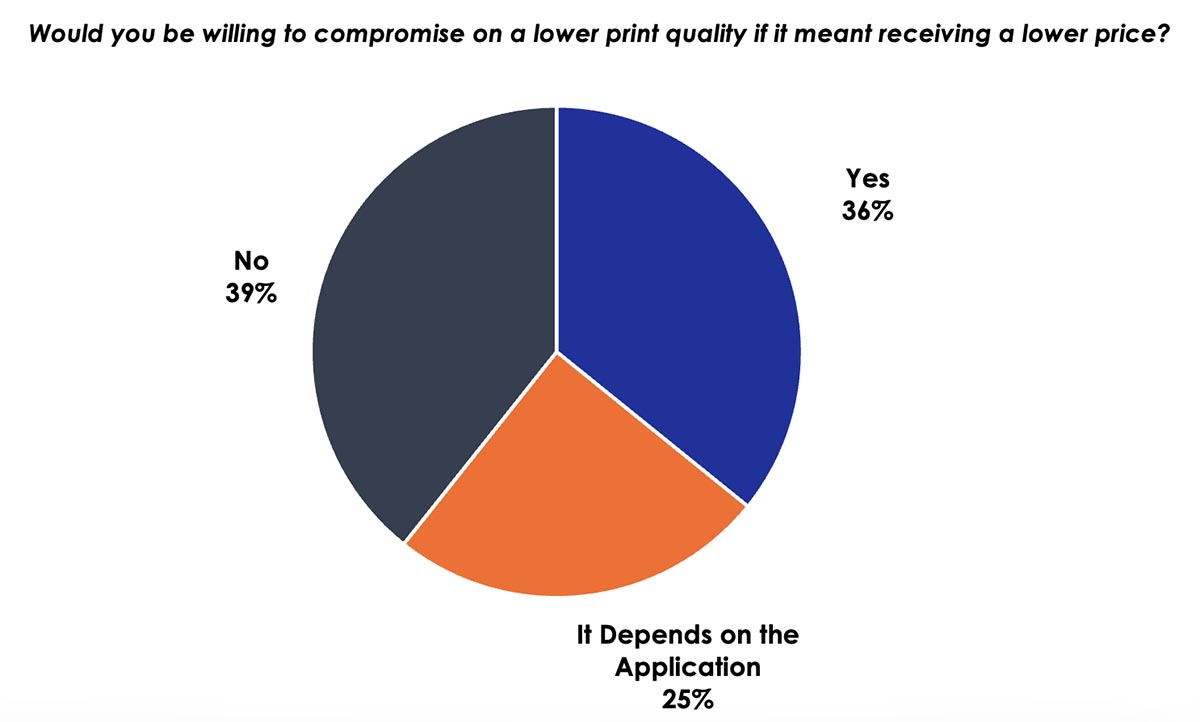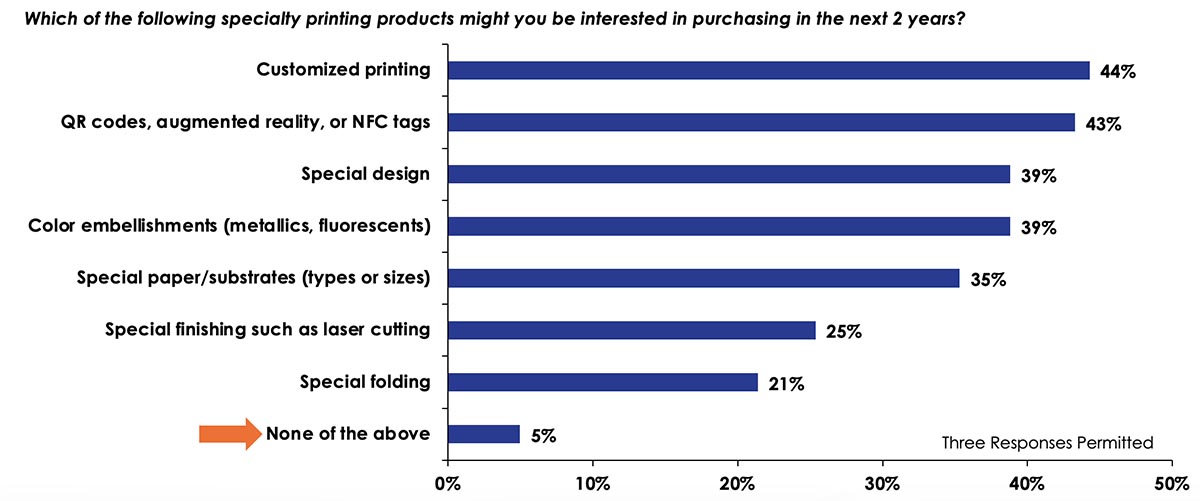- The most popular specialty printing applications among print buyers included customization and digital components like quick response (QR) codes or augmented reality (AR).
- The challenge for PSPs is to learn to understand when their customers will compromise quality for price and when they will require a specialty product that commands a higher price.
- Print samples can be effective, but they must be connected to the print buyer’s primary communication objectives.
By German Sacristan
Introduction
Most businesses involved in the printing supply chain believe that print is not a commodity, and that print buyers will typically make purchases based on value rather than price. To find out what print buyers are really thinking, Keypoint Intelligence recently conducted a primary research survey of over 200 print buyers in the United States. The truth is that price is always a powerful factor in the purchasing decision for all industries, and the printing industry is no exception. This article highlights some of the key findings from our print buyer research to shed some light on their purchasing trends.
What Do Print Buyers Want?
According to Keypoint Intelligence’s primary research on the purchasing trends of print buyers (i.e., marketers) in the United States, over a third of total respondents reported that they would be willing to compromise quality in exchange for a lower price. Another 25% said that it depended on the application, but this ultimately means that price is a key determining factor for over 60% of print buyers.
Figure 1. Compromising Quality for a Lower Price

N = 201 Respondents in the United States
Source: US Print Buyer Purchasing Trends; Keypoint Intelligence 2022
In terms of future purchasing plans, the vast majority of print buyers (95%) expressed interest in purchasing some specialty printing products in the next two years. The most commonly considered applications included customization and digital components like quick response (QR) codes or augmented reality (AR).
Figure 2. Interest in Specialty Printing Products

N = 201 Respondents in the United States
Source: US Print Buyer Purchasing Trends; Keypoint Intelligence 2022
The previous findings could be taken to mean that today’s print buyers basically want everything—the benefits of specialty printing combined with the lowest possible price. The challenge for print service providers (PSPs) is to learn to understand when their customers will compromise quality for price and when they will require a specialty product that commands a higher price. The idea of using a consultative approach when selling print is certainly not new, but it can still be effective.
Many PSPs still solicit customers and prospects with their products and specifications in mind, but this isn’t always the best way to communicate value and differentiate from competitors. In some cases, print buyers will approach a PSP with certain products and specifications already in mind, and will automatically expect a low price.
When it comes to effective selling in today’s market, the key to success is in the approach. We can’t sell value or differentiate ourselves if we don’t understand why someone is requesting a print quote, or the print buyer’s unique opportunities and threats when communicating with their specific markets. Today’s PSPs must understand where the marketer’s communication is going and what they are hoping to convey. Armed with this knowledge, PSPs can make helpful and valuable recommendations that can shift the conversation away from price.
Print salespeople often use samples to communicate quality, and this goes beyond pure printing as certain substrates, sizes, finishes, and colors can also impact the quality of the finished product. Samples can be effective, but they must be connected to the print buyer’s primary communication objectives. The best print sample in the world won’t sell if it isn’t functional for the buyer. Therefore, it will often make sense to show a sample and ask the print buyer a couple of questions, including:
- Do you think this product will help you capture the attention of your customers and prospects?
- Will it elevate your customers’ perception of your brand’s quality and trustworthiness?
The Bottom Line
Today’s print buyers are clearly interested in specialty printing products, and it’s up to salespeople to help buyers understand how these products can make them more effective when they’re communicating with their markets.
Interacting with today’s print buyers requires a focus on ideas that are customized and relevant to them. In most cases, customized campaigns don’t fail because of digital printing capabilities or variable data software—they fail because the marketing strategy and approach are not in line with the customer’s unique requirements. By understanding a customer’s specific business objectives, you can make valuable recommendations that shift the conversation away from price while also differentiating your business from your competitors.
German Sacristan is the Director of Keypoint Intelligence’s Production Print & Media group. In this role, he supports customers with strategic go-to-market advice related to production printing in graphic arts and similar industry segments. German’s responsibilities include conducting market research, industry and technology forecasts, custom consulting and development of analyses, editorial content on technology, as well as support to clients in the areas of production digital printing.














Discussion
By John Zarwan on Mar 02, 2023
Something I’ve thought about a lot. It is not a true commodity because one can distinguish between different print jobs, high quality print and dreck. But it is a commodity in the sense that I challenge any printer to say who printed a piece, or even to be able to identify something they printed.
By Wayne Lynn on Mar 02, 2023
German, this is a very good article. One that few people will truly appreciate. It is forward-looking in that it points out the actions many printers should take to truly lessen the commoditization of the printed product. The key point, among several, is the notion that the printed product, even with all its embellishments, etc. that are offered today, has a purpose outside of its physical characteristics. It leaves the shipping dock in our plant and enters another process designed to achieve a business goal in the customer's business. Add provable value to that downstream process and you are no longer serving a customer whose primary view of you is to provide a tool to minimize total process cost to maximize total business profit in the customer's business. Some experts call it Return on Marketing Costs...
By Robert Godwin on Mar 03, 2023
“In most cases, customized campaigns don’t fail because of digital printing capabilities or variable data software—they fail because the marketing strategy and approach are not in line with the customer’s unique requirements.”
This statement is the essence of why print has become a commodity. All the risk is in a company buying into a marketing strategy and the marketing company executing the program. Printers simply do what they are directed to manufacture. Much lower risk for printers, and accordingly much lower value for what a printer does. If the marketing program is successful as in a positive Return-On-Ad-Spend (ROAS) then the marketing company has increased their value. The amount of risk in an effort informs the value for that effort.
The printer is outside the value loop, residing too far down the value chain of custody. For a printer to grow value they must add services that have value. The advanced capabilities of output devices available on the market has a democratic affect on pricing: If your competitor can achieve the same result, value is diluted. Technology has made complex print projects much easier to achieve; it reduces the risk involved in producing a satisfactory result; and accordingly, the value is reduced.
The question for printers is what will they become that adds value to what they do? Evolving is a challenge that will never cease if value is what you seek.
By Wayne Lynn on Mar 03, 2023
Well said Robert.
By Gordon Pritchard on Mar 03, 2023
Standardization of the “press characteristic” – process hue sets, solid ink densities, dot gain, print contrast, etc. embodied in the print industry standards and specifications has resulted in commoditization of print.
On a sidebar - the word "quality" is used 7 times in the article but is never defined. I wonder what is meant by "quality"? Perhaps, if the word "quality" was replaced with a meaningful descriptor the responses by print buyers would also be more meaningful?
By Michael Kile on Mar 07, 2023
Unfortunatley if you are strictly selling printing it is a commodity. If you are selling solutions that include print it becomes much less of a commodity. For 25 years I was involved with the sales process for some great printing companies, most of which are no longer around. For the last 16 years I owned an AlphaGraphics franchise and soon realized we were in the business of providing solutions for customers with a wide variety of needs. When I started in this business I thought that meant helping small customers with everything from design to delivery but it turned out to be much more than that. It also meant delivering very specific services for larger firms whose biggest concern was whether they could depend on the job being completed correctly and on time (and usually on pretty tight deadlines). Sometimes the actual print portion of some of those projects was not large but if the project was important to them then it was important to us. Becoming a trusted partner who got the job done was what made the relationship work and made it less of a commodity. When selling commerical printing we put a lot of emphasis on "quality" but frankly that became a given for most companies competing in that world. It is also a given in the smaller project world but somehow there is a lot less emphasis placed on that - most of the time I found I was more concerned with the quality of the project than most of my clients. Not being a commodity has more to do with solving problems than with how good your quality is and naturally the more services you provide the more opportunity you have to do that.
By Robert Godwin on Mar 08, 2023
“Risk is like oxygen. You just thrive on it." Reed Hastings, CEO, NETFLIX